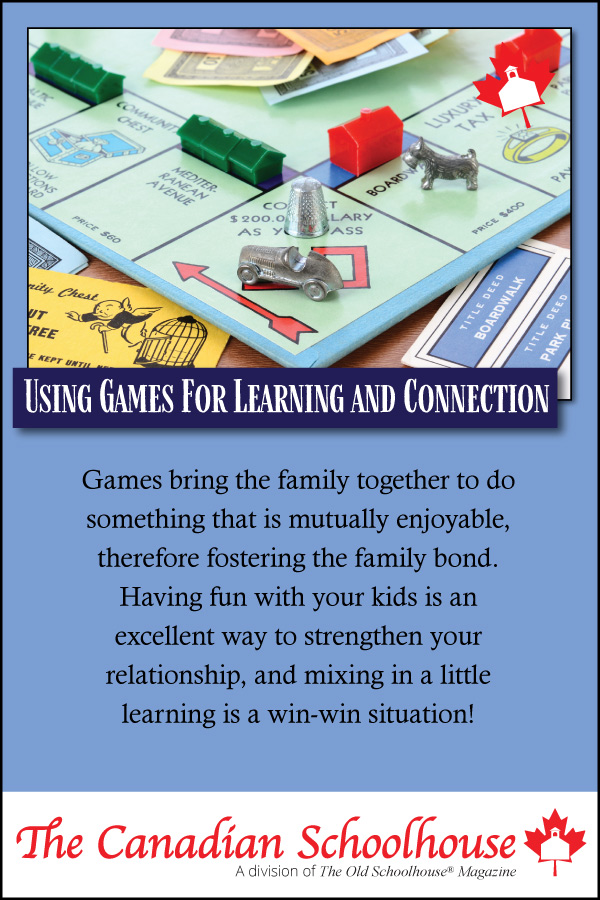

Playing games can be an underrated way to enhance learning and also spend time together as a family. Games bring the family together to do something that is mutually enjoyable, therefore fostering the family bond. Having fun with your kids is an excellent way to strengthen your relationship, and mixing in a little learning is a win-win situation! The possibilities are really endless for games to play with your kids, and most games can be turned into a learning activity for young kids just by having them count or read cards, etc. Below we will share some of our favourite games for learning to bring different ages together.
Fun Games For the Whole Family
How these games enhance learning depends on your child’s age and abilities. We will offer some suggestions, but this is not a comprehensive list. There are many creative ways to incorporate learning into game time. For the littlest learners, it may be beneficial to start them partnering with an older sibling or parent for some of these games until they catch on and have the skills to play on their own. Even as they start to begin to play on their own, you may want to help them with certain aspects of math or reading cards for them as they grow in academics and confidence. Allow them to try and ask for help when they need it. Most of all, make it fun! While games can be educational, they are more importantly relational! This is an excellent way to build family relationships, which will long outlast an education.
Card Games
- Go Fish - While this is predominantly a preschool age game, early elementary students can benefit from it too with some modifications. For example, instead of finding matches, older children can have to find numbers that add to 10 (or 20 if you’re including face cards). This can allow early elementary students to play along with a preschooler. Each child has different types of matches they are looking for.
- Tens - You lay 10 cards out face down in the layout of a 10 frame. The rest of the cards are in the middle with the top one flipped. You are trying to make your 10 frame of cards say numbers 1-10 in order. The first person can choose the upturned card or the top one from the pile. If it is a number they need, they put it in that spot, face up, and turn over the card that was there. If they can use that card they do. That turn continues until the current player flips over a card they cannot use, at which time they put it in the discard pile and it’s the next player’s turn. Game is over when one person has their cards showing A-10 facing up. This is good for young children learning the numbers 1-10.
- Sushi Go
- Skip Bo
- Uno
- Phase 10
- Crib - excellent for quickly adding, mental math, and adding to 15

Board Games
- Ticket to Ride (junior edition is available) - following instructions, reading, strategy
- Settlers of Catan (junior edition is available) - strategy, making a plan, figuring out what to pay in resources
- The Game of Life -money, reading the cards, understanding certain choices and expenses in life
- Monopoly - money, reading the cards
- Sorry - basic counting
- Chess - strategy
- Scrabble - spelling, vocabulary
Other Games
- Quirkle - You can make adaptations for young children where they are just matching the shapes whereas the older ones need to follow the proper rules where they can’t have the same colour in a row.
- Yahtzee - multiplying, skip counting, patterns, basic adding, etc.
- Dominoes - There are so many variations of games to play with dominoes, starting with basic matching and going on to more strategy based like chicken foot, etc.
- Boggle - spelling
More For You
This article about the game Cadoo shows how you can even make the game work for what you want your kids to learn; you aren’t tied to the original rules.
Check out this article to read an awesome breakdown of 60 favourite games for learning, split up by subject.
Also, head on over to our Facebook page and let us know what your favourite games to play with your kids are or how you use games for teaching multiple ages.
This article has been written by homeschooling staff writers of The Canadian Schoolhouse (TCS). Enjoy more of our content from TCS contributors and staff writers by visiting our Front Door page that has content on our monthly theme and links to all our content sections.














